Smart City Data Sensing during COVID-19: Public Reaction to Accelerating Digital Transformation
Abstract
1. Introduction
2. Materials and Methods
2.1. Data
- Data collection period: 1 March 2020 to 1 June 2020.
- Database volume: 11,120,287 words and 85,493,717 characters.
- Number of messages: 161,541.
- Number of active actors: 47,574.
- Number of sources: 1325.
2.2. Method
2.3. Procedures
- Content selection and cleaning (filtering).
- 1.1.
- Isolation and extraction of artificial entities (bots were carried out using a model using neural-like elements with temporal summation of signals.
- 1.2.
- Content clustering was performed using dynamic network metrics, trail metrics, procedures for grouping nodes, identifying local patterns, comparing and contrasting networks, groups, and individuals from a dynamic meta-network perspective
- 2.
- Performing sentiment analysis.
- 3.
- Performing Content Analysis.
- 4.
- Identifying key topics.
- 4.1.
- Selection and analysis of the topic structure.
- 4.2.
- Summarization.
- 5.
- Constructing a semantic network
- 5.1.
- Extraction of the semantic core (nominations with link weights of 98–100).
- 5.2.
- Textual analysis of the semantic core.
- 6.
- Analysis of associative network.
- 6.1.
- Performing an associative search.
- 6.2.
- Word associations
2.4. Tools
3. Results
3.1. General Description of the Content
3.2. Content Sentiment Analysis
3.3. Key Topics of the Content
- Emergence of coronavirus infection in Moscow;
- Coronavirus spread in the Moscow region;
- Pandemic spread throughout Russia;
- Discussion of the specifics of the new disease (Appendix A).
- Discussion of the measures taken to fight the infection spread;
- Health problems that have worsened since the beginning of the quarantine;
- Criticism of the actions of the authorities regarding the fight against the coronavirus infection;
- Political issues;
- Discussion of constitutional amendments (Appendix B).
3.4. Core of the Semantic Network
3.5. Associative Network
- Stimulus online-services (10/99,460) (Figure 13)
- Stimulus online-medicine (10/84,101) (Figure 14)
- Stimulus distance learning (10/77,131) (Figure 15)
- Stimulus distance work (10/75,473) (Figure 16)
- Stimulus digital pass (10/66,653) (Figure 17)
- Stimulus electronic pass (10/63,726) (Figure 18)
- Stimulus surveillance cameras (10/35,468) (Figure 19)
- Stimulus Government Services (10/32,509) (Figure 20)
4. Discussion
5. Conclusions
Author Contributions
Funding
Institutional Review Board Statement
Informed Consent Statement
Data Availability Statement
Conflicts of Interest
Appendix A
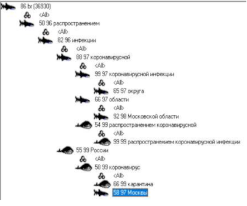
Appendix B
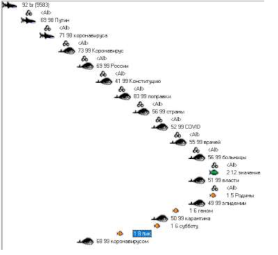
References
- Akib, T.B.A.; Mou, S.F.; Rahman, M.M.; Rana, M.M.; Islam, M.R.; Mehedi, I.M.; Mahmud, M.A.P.; Kouzani, A.Z. Design and Numerical Analysis of a Graphene-Coated SPR Biosensor for Rapid Detection of the Novel Coronavirus. Sensors 2021, 21, 3491. [Google Scholar] [CrossRef]
- Raposo, A.; Marques, L.; Correia, R.; Melo, F.; Valente, J.; Pereira, T.; Rosário, L.B.; Froes, F.; Sanches, J.; Silva, H.P.d. e-CoVig: A Novel mHealth System for Remote Monitoring of Symptoms in COVID-19. Sensors 2021, 21, 3397. [Google Scholar] [CrossRef]
- Rehman, M.U.; Shafique, A.; Khalid, S.; Driss, M.; Rubaiee, S. Future Forecasting of COVID-19: A Supervised Learning Approach. Sensors 2021, 21, 3322. [Google Scholar] [CrossRef] [PubMed]
- Purnomo, A.T.; Lin, D.-B.; Adiprabowo, T.; Hendria, W.F. Non-Contact Monitoring and Classification of Breathing Pattern for the Supervision of People Infected by COVID-19. Sensors 2021, 21, 3172. [Google Scholar] [CrossRef] [PubMed]
- Bermejo-Gil, B.M.; Pérez-Robledo, F.; Llamas-Ramos, R.; Silva, L.A.; Sales-Mendes, A.; Leithardt, V.R.Q.; Llamas-Ramos, I. RespiraConNosotros: A Viable Home-Based Telerehabilitation System for Respiratory Patients. Sensors 2021, 21, 3318. [Google Scholar] [CrossRef]
- De Sanctis, M.; Conte, A.; Rossi, T.; Di Domenico, S.; Cianca, E. CIR-Based Device-Free People Counting via UWB Signals. Sensors 2021, 21, 3296. [Google Scholar] [CrossRef] [PubMed]
- Janssen, M.; Kuk, G. The challenges and limits of big data algorithms in technocratic governance. Gov. Inf. Q. 2016, 33, 371–377. [Google Scholar] [CrossRef]
- Carrasco, M.; Mills, S.; Whybrew, A.; Jura, A. The Citizen’s Perspective on the Use of AI in Government: BCG Digital Government Benchmarking; Boston Consulting Group: Boston, IL, USA, 2019; Available online: https://image-src.bcg.com/Images/BCG-The-Citizens-Perspective-on-the-Use-of-Artifical-Intelligence-Mar-2019_tcm27-215068.pdf (accessed on 8 March 2021).
- Armendia, M.; Ghassempouri, M.; Ozturk, E.; Peysson, F. Twin-Control. In A Digital Twin Approach to Improve Machine Tools Lifecycle; Springer International Publishing: Cham, Switzerland, 2019; pp. 1–296. [Google Scholar]
- Herwig, C.; Pörtner, R.; Möller, J. Digital Twins. In Tools and Concepts for Smart Biomanufacturing; Springer International Publishing: Cham, Switzerland, 2021; pp. 1–262. [Google Scholar]
- Farsi, M.; Daneshkhah, A.; Hosseinian-Far, A.; Jahankhani, H. (Eds.) Digital Twin Technologies and Smart Cities; Springer International Publishing: Cham, Switzerland, 2020; pp. 1–212. [Google Scholar]
- Tao, L. Shenzhen AI Start-Up Intellifusion Helps City Police Identify Jaywalkers and Banned Drivers. South China Morning Post. Available online: https://www.scmp.com/tech/start-ups/article/3008700/shenzhen-ai-start-intellifusion-helps-city-police-identify (accessed on 17 March 2021).
- Shenzhen Traffic Police Bureau and Huawei Jointly Create a Futuristic ‘City-wide Traffic Brain’ for Safe City Driving. Huawei, 2018. Available online: https://e.huawei.com/topic/leading-new-ict-ru/shenzhen-traffic-police.html (accessed on 27 March 2021).
- Ferrer, J.N.; Taranic, I.; Veum, K.; Paul van den, O.; Cordelia, W. The Making of a Smart City: Policy Recommendations. EU Smart City Information System. European Commission, 2019. Available online: https://smartcities-infosystem.eu/sites/default/files/document/the_making_of_a_smart_city_-_policy_recommendations.pdf (accessed on 4 March 2021).
- Ethics and “Digital”: Ethical Problems of Digital Technologies. Analytical Report; RANEPA: Moscow, Russia, 2019; Available online: https://ethics.cdto.center/ (accessed on 2 March 2021).
- How Toronto Locals Soured on Alphabet’s Neighborhood of the Future. Available online: https://www.fastcompany.com/90390377/alphabet-wants-to-turn-toronto-into-a-digital-city-locals-arent-so-sure (accessed on 7 March 2021).
- GovInsider Guide to Smart Cities. GovInsider, 2018. Available online: https://govinsider.asia/smart-gov/the-govinsider-guide-to-urban-design-and-smart-cities/ (accessed on 6 March 2021).
- Glik, D. Risk communication for public health emergencies. Annu. Rev. Public Health 2007, 28, 33–54. [Google Scholar] [CrossRef] [PubMed]
- Stefanidis, A.; Vraga, E.; Lamprianidis, G.; Radzikowski, J.; Delamater, P.L.; Jacobsen, K.H.; Crooks, A. Zika in Twitter: Temporal variations of locations, actors, and concepts. JMIR Public Health Surveill. 2017, 3, e22. [Google Scholar] [CrossRef]
- Roundtree, A.K. Hospital Tweets on H1N1 and Death Panels: Text Mining the Situational Crisis Communication Response to Health Crises and Controversies. Kome Int. J. Pure Commun. Inq. 2018, 6, 32–62. [Google Scholar] [CrossRef]
- Garrett, L. Understanding media’s response to epidemics. Public Health Rep. 2001, 116, 87–97. [Google Scholar] [CrossRef]
- Heydari, S.T.; Zarei, L.; Sadati, A.K.; Moradi, N.; Akbari, M.; Mehralian, G.; Lankarani, K.B. The effect of risk communication on preventive and protective Behaviours during the COVID-19 outbreak: Mediating role of risk perception. BMC Public Health 2021, 21, 54–75. [Google Scholar] [CrossRef]
- Liao, H.P.; Wang, J.L. The impact of epidemic information on the public’s worries and attitude toward epidemic prevention measures during the COVID-19 outbreak. Chinese Med. J. 2021, 134, 879–880. [Google Scholar]
- Martín-Moreno, J.M.; Arenas, A.; Bengoa, R.; Borrell, C.; Franco, M.; García-Basteiro, A.L.; Gestal, J.; González López-Valcárcel, B.; Hernández Aguado, I.; Legido-Quigley, H.; et al. Reflexiones Sobre Cómo Evaluar y Mejorar la Respuesta a la Pandemia de COVID-19. Gaceta Sanitaria 2020. Available online: https://www.sciencedirect.com/science/article/pii/S0213911120302545 (accessed on 4 April 2021).
- Casero-Ripollés, A. Impact of Covid-19 on the media system. Communicative and democratic consequences of news consumption during the outbreak. El Prof. Inf. 2020, 29, e290223. [Google Scholar] [CrossRef]
- Linzen, T. What can linguistics and deep learning contribute to each other? Response to Pater. Language 2018, 95, e108–e199. [Google Scholar]
- Quick, L. Managing Events: Real Challenges, Real Outcomes; SAGE Publications Ltd.: Thousand Oaks, CA, USA, 2020; p. 480. [Google Scholar]
- Hobbs, A. Leadership during COVID-19: Conflict and Collaboration; SAGE Publications: Thousand Oaks, CA, USA, 2020; p. 506. [Google Scholar]
- Liu, B. Sentiment Analysis and Opinion Mining (Synthesis Lectures on Human Language Technologies); Morgan & Claypool Publishers: San Rafael, CA, USA, 2012; p. 212. [Google Scholar]
- Matalon, Y.; Magdaci, O.; Almozlino, A.; Yamin, D. Using sentiment analysis to predict opinion inversion in Tweets of political communication. Sci. Rep. 2021, 11, 7250. [Google Scholar] [CrossRef] [PubMed]
- Birjali, M.; Kasri, M.; Beni-Hssane, A. A comprehensive survey on sentiment analysis: Approaches, challenges and trends. Knowl. Based Syst. 2021, 226, 107134. [Google Scholar] [CrossRef]
- Singh, M.; Jakhar, A.K.; Pandey, S. Sentiment analysis on the impact of coronavirus in social life using the BERT model. Soc. Netw. Anal. Min. 2021, 11, 1. [Google Scholar] [CrossRef]
- Chandrasekaran, R.; Mehta, V.; Valkunde, T.; Moustakas, E. Topics, Trends, and Sentiments of Tweets about the COVID-19 Pandemic: Temporal Infoveillance Study. J. Med. Internet Res. 2020, 22, e22624. [Google Scholar] [CrossRef]
- Valdez, D.; Ten Thij, M.; Bathina, K.; Rutter, L.A.; Bollen, J. Social Media Insights Into US Mental Health During the COVID-19 Pandemic: Longitudinal Analysis of Twitter Data. J. Med. Internet Res. 2020, 22, e21418. [Google Scholar] [CrossRef]
- Abd-Alrazaq, A.; Alhuwail, D.; Househ, M.; Hamdi, M.; Shah, Z. Top Concerns of Tweeters during the COVID-19 Pandemic: Infoveillance Study. J. Med. Internet Res. 2020, 22, e19016. [Google Scholar] [CrossRef]
- Medford, R.J.; Saleh, S.N.; Sumarsono, A.; Perl, T.M.; Lehmann, C.U. An “Infodemic”: Leveraging High-Volume Twitter Data to Understand Early Public Sentiment for the Coronavirus Disease 2019 Outbreak. Open Forum Infect Dis. 2020, 7, ofaa258. [Google Scholar] [CrossRef] [PubMed]
- Yu, H.; Bae, J.; Choi, J.; Kim, H. LUX: Smart Mirror with Sentiment Analysis for Mental Comfort. Sensors 2021, 21, 3092. [Google Scholar] [CrossRef] [PubMed]
- Kharlamov, A.; Pilgun, M. (Eds.) Neuroinformatics and Semantic Representations. Theory and Applications; Cambridge Scholars Publishing: Newcastle upon Tyne, UK, 2020; p. 317. [Google Scholar]
- White, M.D.; Marsh, E. Content analysis: A flexible methodology. Library Trends 2006, 1, 22–45. [Google Scholar] [CrossRef]
- Krippendorff, K. Content Analysis. An Introduction to Its Methodology, 3rd ed.; SAGE Publications, Inc.: Los Angeles, CA, USA, 2012; p. 441. [Google Scholar]
- Westhead, D.; Vijayabaskar, M.S. (Eds.) Hidden Markov Models. Methods and Protocols; Humana Press: Totowa, NJ, USA, 2017; p. 221. [Google Scholar]
- McCallum, A.; Nigam, K. A Comparison of Event Models for Naive Bayes Text Classificatio. In AAAI/ICML-98 Workshop on Learning for Text Categorization; Technical Report WS-98-05; AAAI Press: Palo Alto, CA, USA, 1998; pp. 41–48. [Google Scholar]
- Bishop, C.M. Pattern Recognition and Machine Learning; Springer: Cham, Switzerland, 2006; p. 312. [Google Scholar]
- Sutton, C.; McCallum, A. Introduction to Conditional Random Fields for Relational Learning; MIT Press: Cambridge, MA, USA, 2006; p. 363. [Google Scholar]
- Sarawagi, S. Information extraction. Found. Trends Databases 2008, 1, 261–377. [Google Scholar] [CrossRef]
- Stanford Named Entity Recognizer. Available online: http://www-nlp.stanford.edu/software/CRF-NER.shtml (accessed on 1 March 2021).
- Al-Turjman, F.; Devi, V.; Nayyar, A. (Eds.) Emerging Technologies for Battling Covid-19. Applications and Innovation; Springer International Publishing: Cham, Switzerland, 2021; p. 359. [Google Scholar]
- Santosh, K.C.; Joshi, A. (Eds.) COVID-19: Prediction, Decision-Making, and Its Impacts; Springer Singapore: Singapore, 2021; p. 234. [Google Scholar]
- Raza, K. (Ed.) Computational Intelligence Methods in COVID-19: Surveillance, Prevention, Prediction and Diagnosis; Springer Singapore: Singapore, 2021; p. 334. [Google Scholar]
- Joshi, A.; Dey, N.; Santosh, K.C. (Eds.) Intelligent Systems and Methods to Combat Covid-19; Springer Singapore: Singapore, 2020; p. 324. [Google Scholar]
- Khosla, P.K.; Mittal, M.; Sharma, D.; Goyal, L.M. (Eds.) Predictive and Preventive Measures for Covid-19 Pandemic; Springer Singapore: Singapore, 2021; p. 434. [Google Scholar]
- Hassanien, A.; Dey, N.; Elghamrawy, S.M. (Eds.) Big Data Analytics and Artificial Intelligence against COVID-19: Innovation Vision and Approach; Springer International Publishing: Cham, Switzerland, 2020; p. 345. [Google Scholar]
- Fong, S.J.; Dey, N.; Chaki, J. Artificial Intelligence for Coronavirus Outbreak; Springer Singapore: Singapore, 2021; p. 234. [Google Scholar]
- Niranjanamurthy, M.B.; Siddhartha, K.N. (Eds.) Intelligent Data Analysis for COVID-19 Pandemic; Springer Singapore: Singapore, 2021; p. 245. [Google Scholar]
- Devasena, T. Nanotechnology-COVID-19 Interface; Springer Singapore: Singapore, 2021; p. 145. [Google Scholar]
- Stepantsov, P.M.; Kartavtsev, V.V.; Bode, M.M.; Stepantsova, Y.A. Digital Turn. In Economic Consequences of the Pandemic and New Strategies; RANEPA: Moscow, Russia, 2021; p. 231. [Google Scholar]
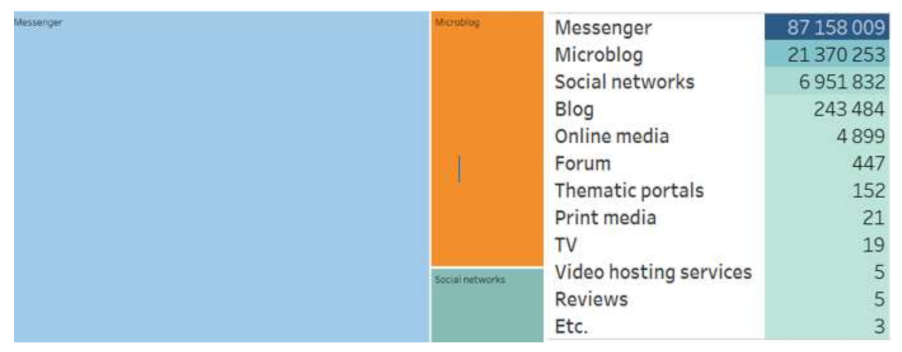

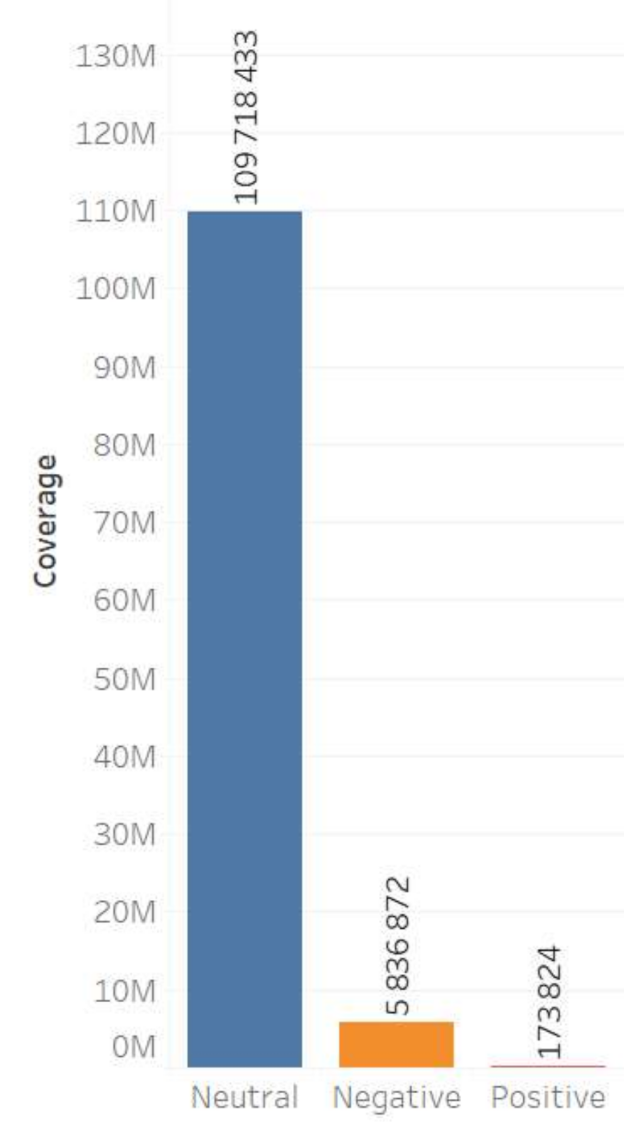

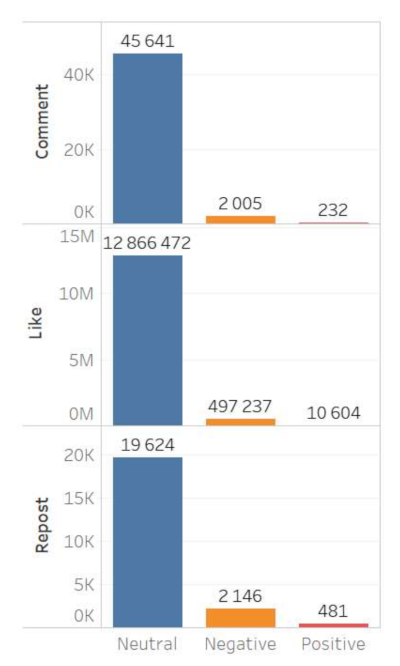
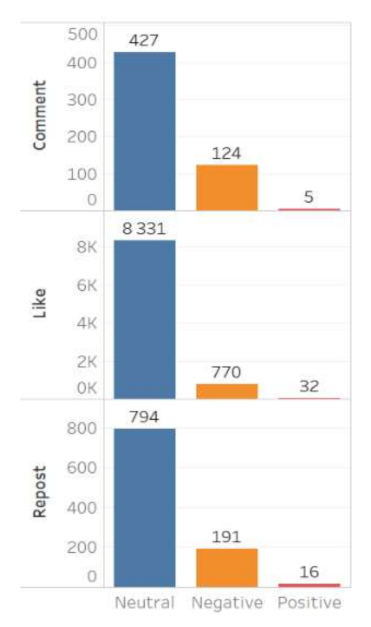
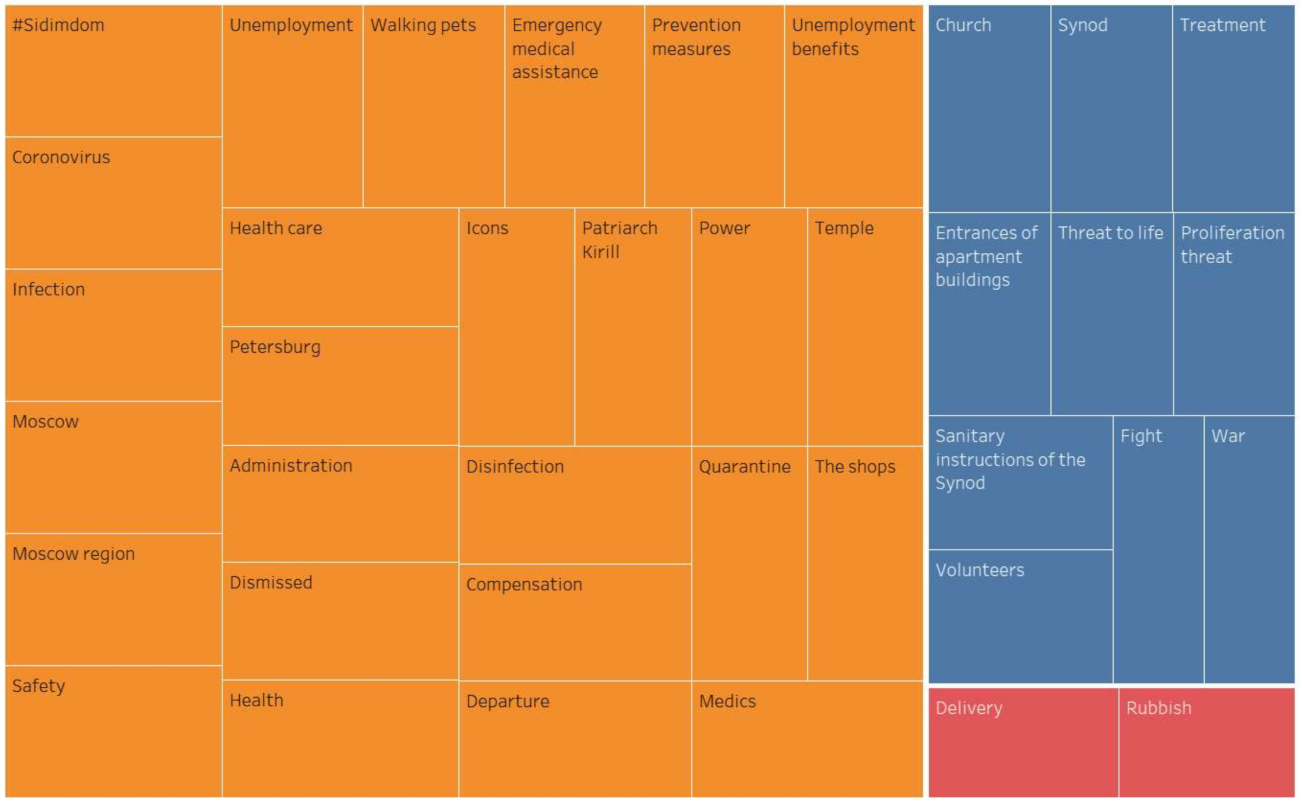
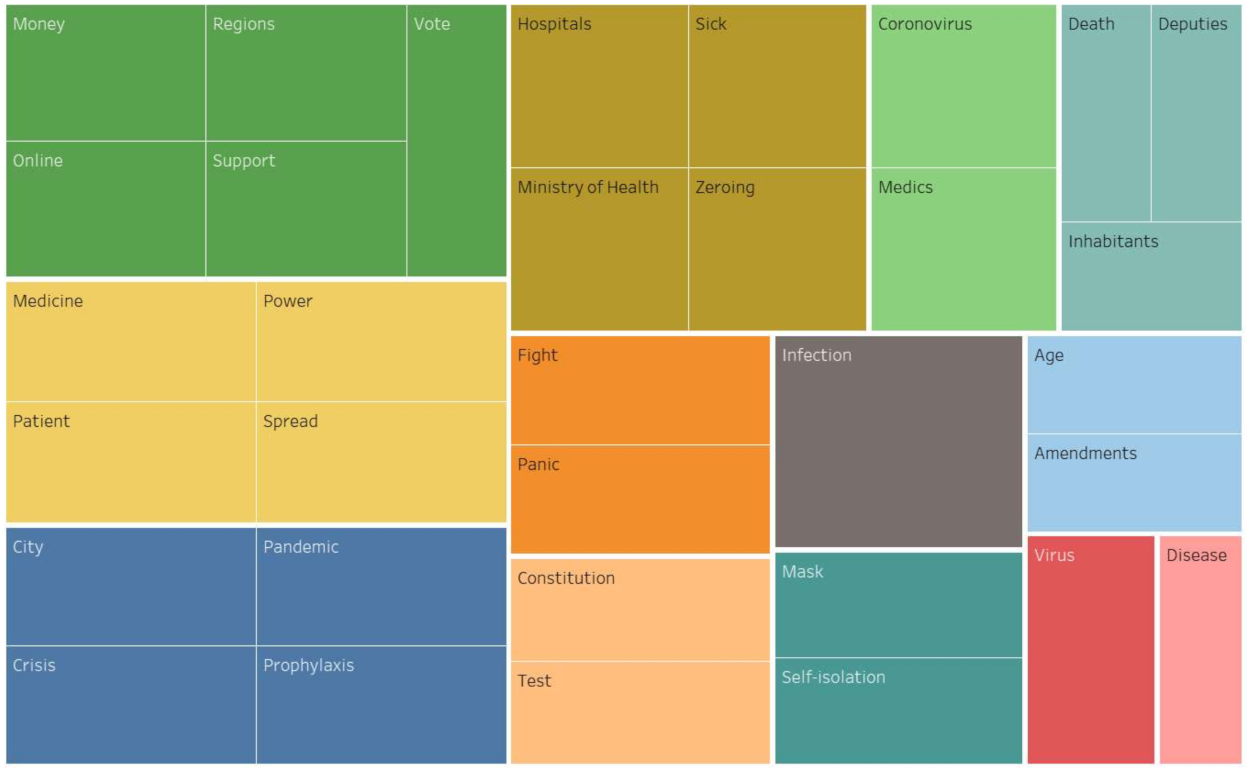

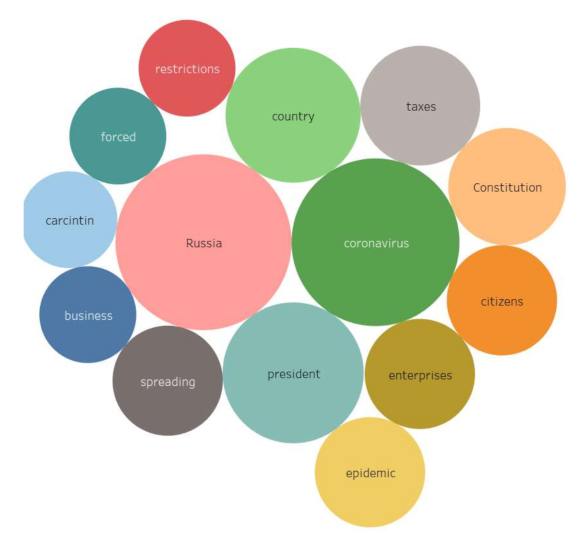

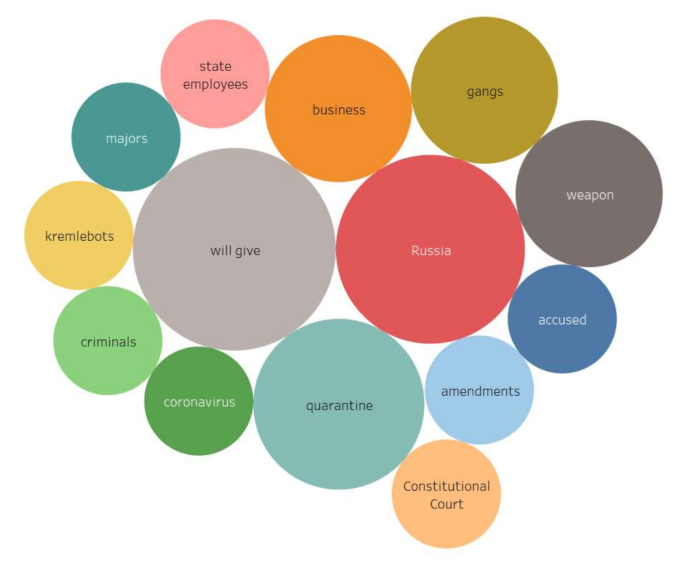
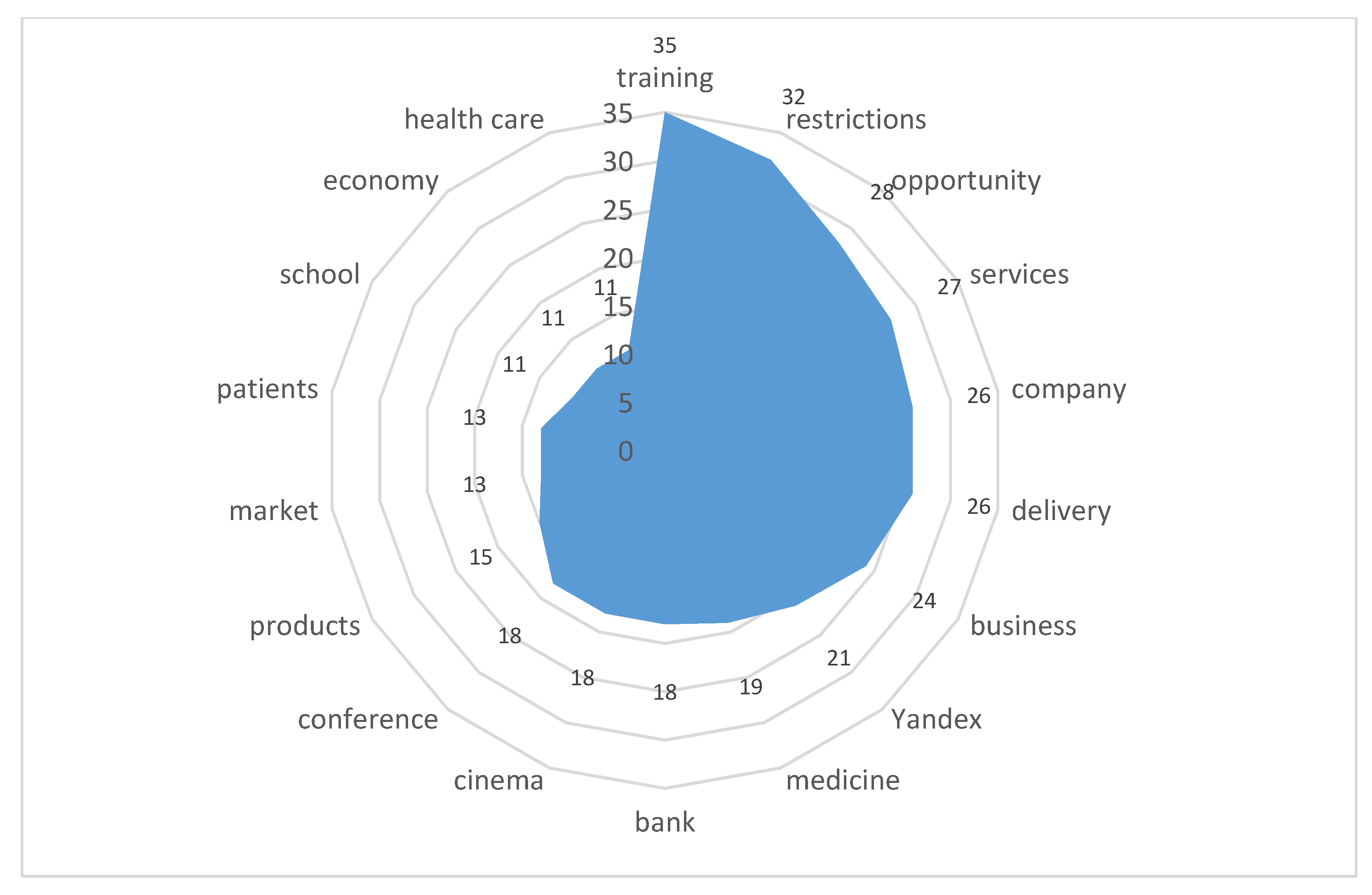
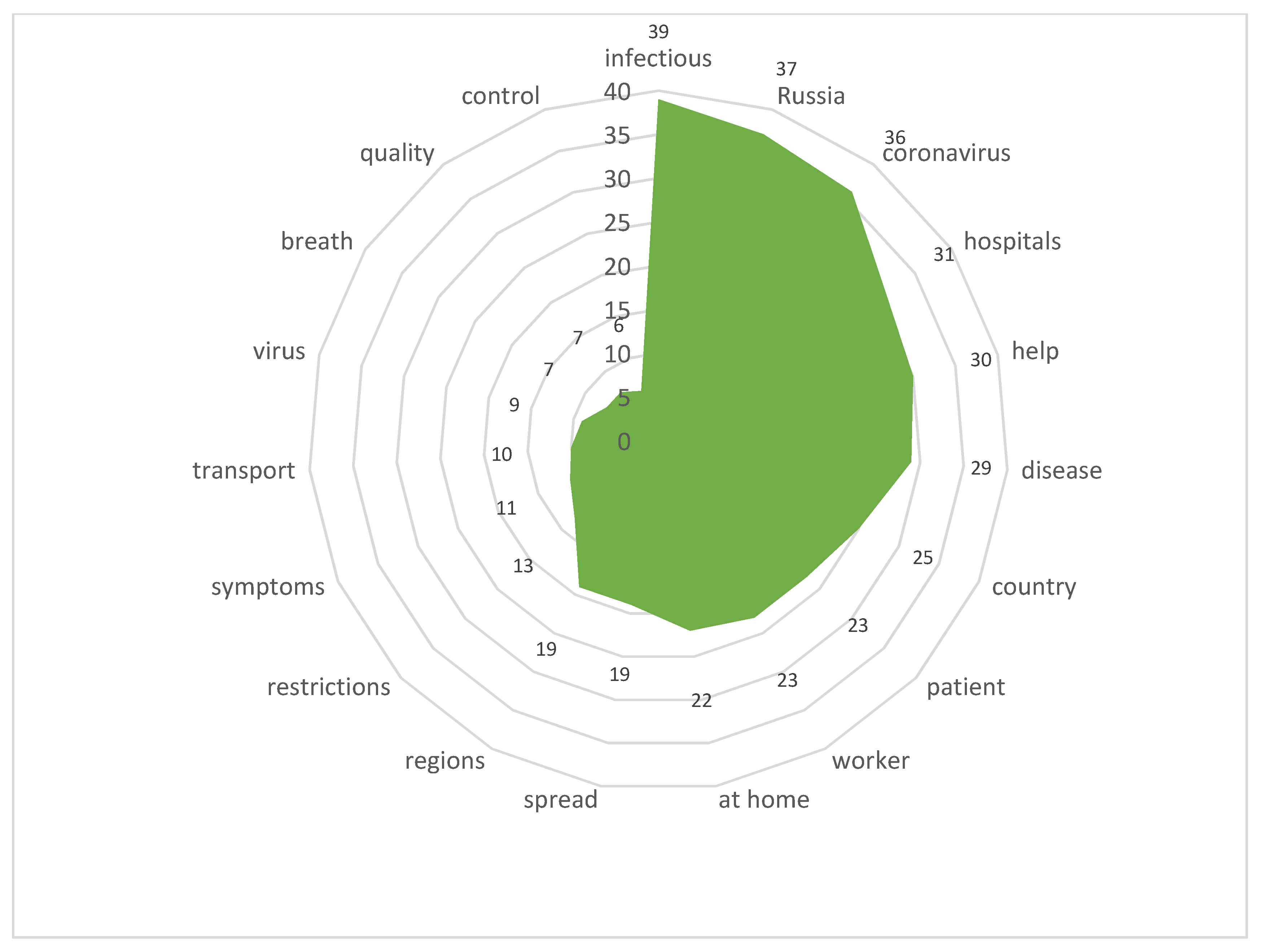

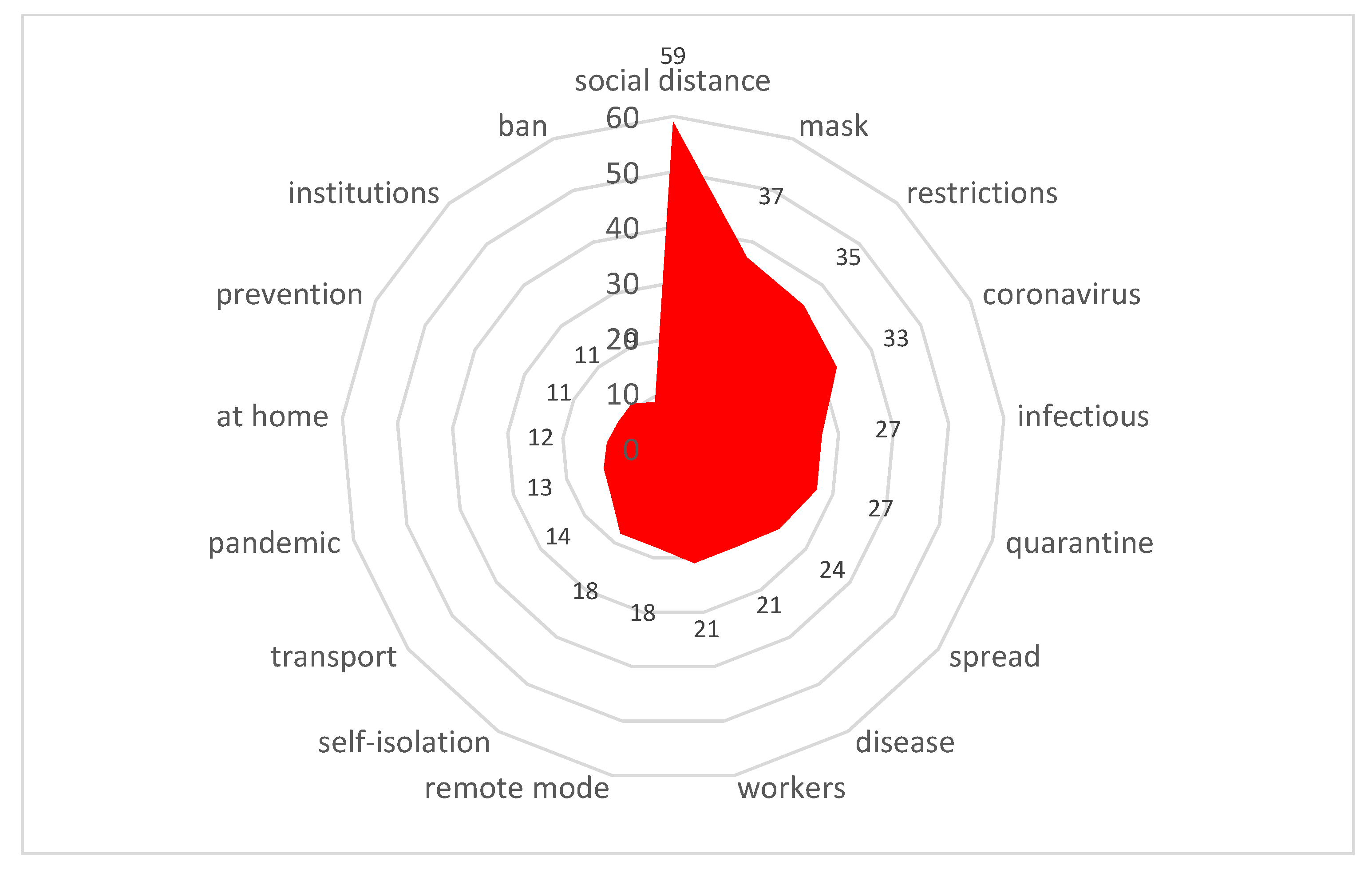
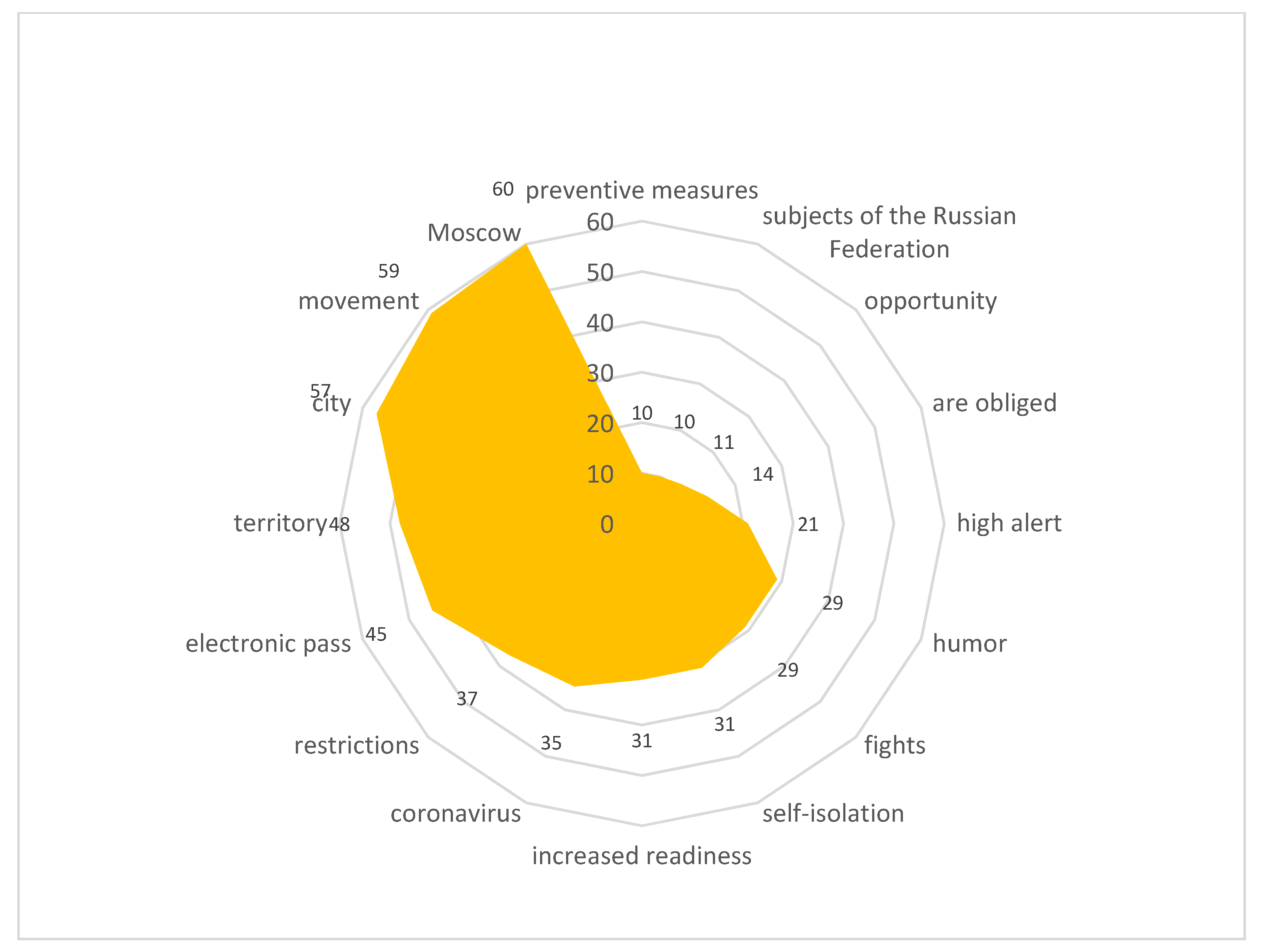

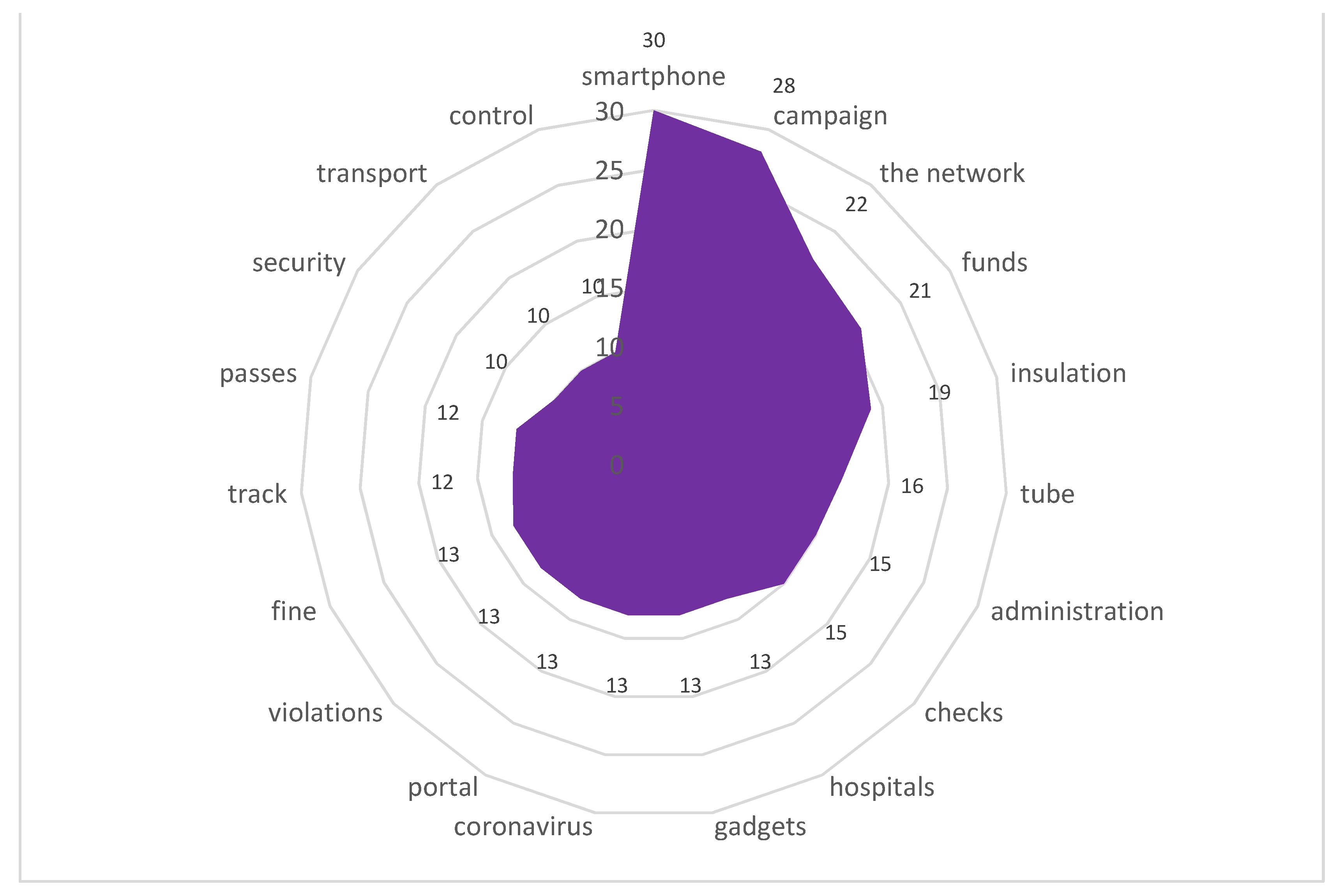
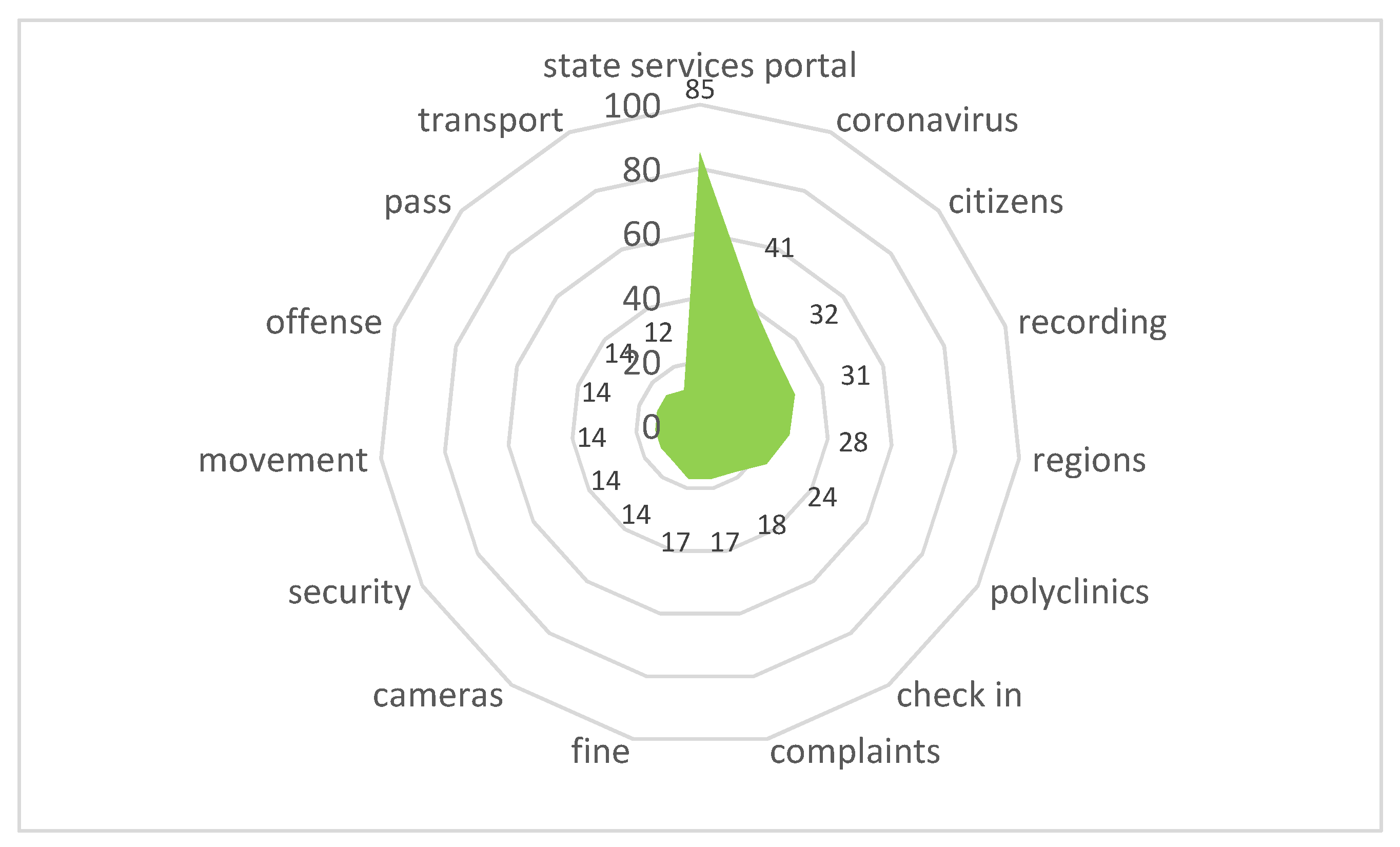
Publisher’s Note: MDPI stays neutral with regard to jurisdictional claims in published maps and institutional affiliations. |
© 2021 by the authors. Licensee MDPI, Basel, Switzerland. This article is an open access article distributed under the terms and conditions of the Creative Commons Attribution (CC BY) license (https://creativecommons.org/licenses/by/4.0/).
Share and Cite
Kharlamov, A.A.; Raskhodchikov, A.N.; Pilgun, M. Smart City Data Sensing during COVID-19: Public Reaction to Accelerating Digital Transformation. Sensors 2021, 21, 3965. https://doi.org/10.3390/s21123965
Kharlamov AA, Raskhodchikov AN, Pilgun M. Smart City Data Sensing during COVID-19: Public Reaction to Accelerating Digital Transformation. Sensors. 2021; 21(12):3965. https://doi.org/10.3390/s21123965
Chicago/Turabian StyleKharlamov, Alexander A., Aleksei N. Raskhodchikov, and Maria Pilgun. 2021. "Smart City Data Sensing during COVID-19: Public Reaction to Accelerating Digital Transformation" Sensors 21, no. 12: 3965. https://doi.org/10.3390/s21123965
APA StyleKharlamov, A. A., Raskhodchikov, A. N., & Pilgun, M. (2021). Smart City Data Sensing during COVID-19: Public Reaction to Accelerating Digital Transformation. Sensors, 21(12), 3965. https://doi.org/10.3390/s21123965






